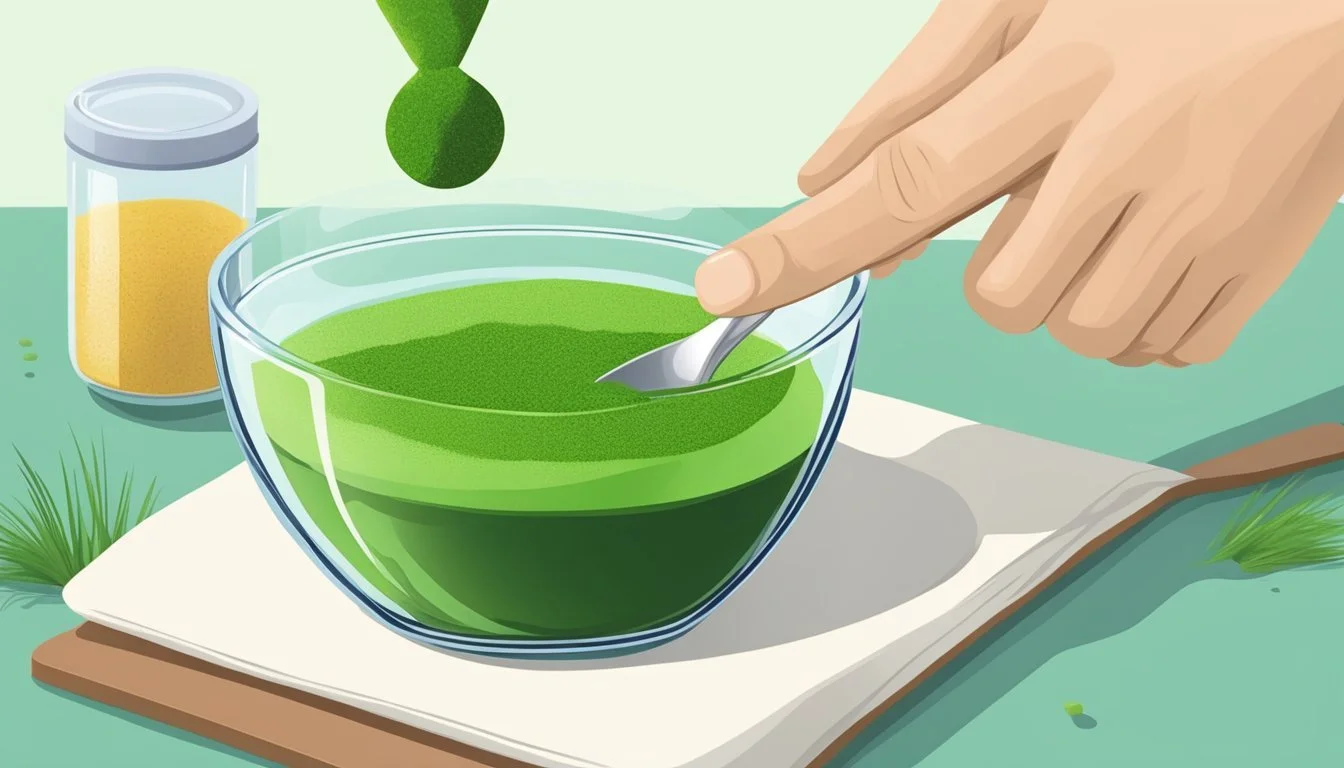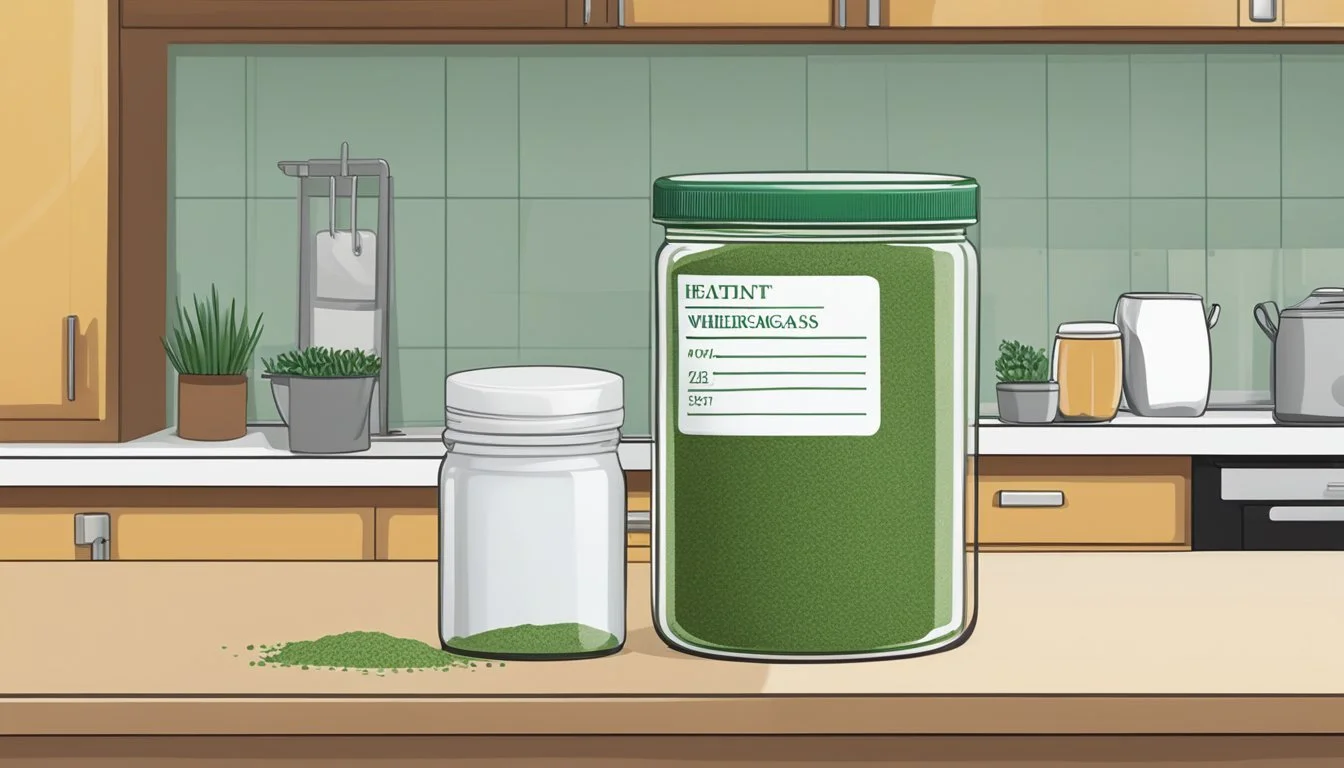How Long Does Wheatgrass Powder Last?
Shelf Life and Storage Tips
Wheatgrass powder (how long does wheatgrass powder last?) is well-regarded for its health benefits, often attributed to its dense nutritional profile that includes enzymes, vitamins, and minerals. It has become a staple in the diets of health-conscious individuals who seek to take advantage of its purported capabilities such as detoxification and immune system support.
As a dry product, wheatgrass powder enjoys a substantial shelf life, typically ranging from two to three years when unopened and stored correctly. The longevity of the powder depends on factors like storage conditions, with ideal storage being in a cool, dry, and dark place to preserve its nutritional content. Once opened, it's generally recommended to use the wheatgrass powder within three to six months to ensure the potency of its nutrients, as exposure to air, moisture, and light can accelerate the degradation process.
Consumers are advised to observe the expiration date provided by manufacturers to maximize the benefits of wheatgrass powder. Using the powder beyond this date may not pose a health risk, but it can lead to a significant reduction in its nutritional value. Therefore, for those seeking to incorporate wheatgrass into their lifestyle for its health benefits, it is crucial to manage its consumption within the appropriate time frame to benefit from its nutritional offerings.
Understanding Wheatgrass
Wheatgrass is recognized for its dense concentration of nutrients and associated health benefits in its various forms.
Nutritional Profile of Wheatgrass
Wheatgrass is exceptionally rich in vital nutrients. It boasts a high content of vitamins such as Vitamin A, E, and C, and is a good source of calcium, iron, and magnesium. Additionally, it contains chlorophyll, enzymes, and antioxidants which play crucial roles in the body's metabolic processes.
Nutrient Benefit Vitamins A, E, C Antioxidant properties, immune support Calcium Bone health Iron Oxygen transport, energy creation Magnesium Muscle function, nerve function Chlorophyll Wound healing, detoxification Enzymes Digestion and metabolism Antioxidants Counteracting oxidative stress
Health Benefits of Wheatgrass
Consuming wheatgrass can contribute to overall well-being. The enzymes in wheatgrass aid in digestion and can boost metabolism. The abundance of antioxidants helps in neutralizing free radicals, potentially reducing the risk of chronic diseases. Chlorophyll present in the grass is known for its detoxifying effects, and the minerals like iron and calcium support essential bodily functions.
Different Forms of Wheatgrass
Wheatgrass is available in several forms, each offering a way to incorporate these nutrients into one's diet. Fresh wheatgrass can be juiced for a quick shot of concentrated nutrients, while wheatgrass powder provides a more shelf-stable option that can be easily added to smoothies, juices, or water. The powdered form is known to have a longer shelf life, typically ranging from two to three years, depending on storage conditions.
Shelf Life Fundamentals
The longevity of wheatgrass powder hinges on proper storage practices and an awareness of spoilage indicators. Manufacturers typically provide a use-by date that suggests an optimal consumption window to ensure freshness and nutrient retention.
Factors Affecting Shelf Life
Heat: Elevated temperatures can accelerate the degradation of wheatgrass powder, leading to the loss of nutritional value and a shorter shelf life.
Moisture: Wheatgrass powder should be stored in a dry environment since moisture can promote bacterial growth and spoilage.
Storage: Proper storage involves sealing the wheatgrass powder in an air-tight container, away from direct light, to maximize shelf life.
Expiration Date: A reliable indicator of product longevity is the expiration date, which typically allows for a shelf life of two to three years when conditions are optimal.
Identifying Spoilage Signs
Mold Presence: Visible mold growth is a definitive sign of spoilage in wheatgrass powder.
Odor Changes: Any off-putting or unusual smells can indicate that the wheatgrass powder has gone bad.
Proper Storage Techniques
Ensuring the longevity of wheatgrass, whether in powder form or fresh, hinges on adhering to proper storage methods. Both forms require conditions that protect against factors that can degrade their quality.
Storing Powdered Wheatgrass
Powdered wheatgrass benefits from being stored in a cool, dark place to keep its nutritional content intact. It’s crucial to use airtight containers, as exposure to air can hasten degradation. Glass jars are recommended for this purpose. A pantry or kitchen cabinet away from direct sunlight and fluctuations in temperature forms an ideal storage location. Under these conditions, wheatgrass powder can maintain its quality for approximately two to three years.
Ideal location: Pantry or dark cabinet
Temperature: Room temperature, away from heat sources
Container: Airtight containers, preferably glass jars
Storing Fresh Wheatgrass
Fresh wheatgrass requires a bit more care. It should be wrapped in a damp paper towel to retain moisture and then placed in an organic food storage container. The key is to ensure it is not exposed to direct air, which could cause it to wilt or spoil.
Preparation: Wrap in a damp paper towel
Container: Organic, airtight food storage container
Additional Tip: Check moisture regularly to maintain freshness
Use of Refrigeration and Freezing
To extend the shelf life of fresh wheatgrass, refrigeration is recommended. Stored in this manner, fresh wheatgrass can last for up to a week without significant loss of quality, provided moisture levels are managed. For long-term storage, freezing is an effective method. Blanching wheatgrass prior to freezing can help preserve its color and nutritional properties. Individual portions should then be placed into freezer-safe containers.
Refrigerator: Up to one week, monitor moisture levels
Freezer: Blanch before freezing, store in portions using freezer-safe containers
Consuming Wheatgrass Efficiently
To consume wheatgrass powder effectively, one must consider how to incorporate it into their diet and the preparation methods that maintain its nutritional integrity. The goal is to utilize wheatgrass efficiently for its potential benefits in uplifting energy levels and contributing to nutrient intake.
Incorporating Wheatgrass into Diets
Introducing wheatgrass into a diet can be accomplished in a variety of ways. Because wheatgrass powder is a concentrated source of nutrients commonly known as a superfood, individuals often mix the powder with water to create a simple shot. For those new to wheatgrass, gradually adding it to their diet is recommended to assess tolerance.
To facilitate a consistent intake, the powder can be seamlessly added to smoothies or fruit juices, enriching these beverages with additional nutrients. Integrating wheatgrass into one’s daily routine, such as having a wheatgrass shot first thing in the morning or including it in a post-workout smoothie, can help maintain stable energy levels throughout the day.
Recipes and Preparation
When preparing wheatgrass, freshness and proper storage play crucial roles in preserving its benefits. Wheatgrass powder should be stored in a cool, dark place to ensure its longevity, which can be up to two to three years. Here are common recipes and preparation tips for wheatgrass:
Wheatgrass Juice: Mix 1 teaspoon of wheatgrass powder with 6-8 ounces of water or fruit juice. Stir well until fully dissolved.
Smoothie: Add 1 teaspoon of wheatgrass powder to a blender with your choice of fruits, vegetables, and a liquid base, such as almond milk or coconut water.
It is important to follow the storage instructions to maximize the powder's shelf life. After opening, some users may prefer to store their powder in the refrigerator to keep it fresh, especially in warmer climates. The efficacy of wheatgrass is not just in how one consumes it but also in the care taken to preserve its quality.
Health Considerations and Side Effects
When considering the inclusion of wheatgrass powder in one's diet, it's important to weigh its potential health benefits against possible side effects. While wheatgrass is a source of nutrients, individual reactions can vary, highlighting the need for awareness about its risks as well as its benefits.
Potential Benefits and Risks
Wheatgrass is often labeled as a superfood due to its high nutritional value, including vitamins, minerals, and antioxidants. Regular consumption of wheatgrass may contribute to improved cholesterol levels and aid in the management of diabetes. Its anti-inflammatory properties may benefit those with conditions such as arthritis. However, the term superfood can be misleading—it does not guarantee health improvements and should not replace a balanced diet.
Risks associated with wheatgrass intake primarily relate to its side effects. Some individuals may experience nausea or an upset stomach, especially when ingesting wheatgrass in large amounts. Overconsumption might also lead to more severe reactions.
Digestive side effects: Nausea, upset stomach
Long-term risks: Unexplored, but caution is advised with excessive use
Managing Allergic Reactions
Individuals with celiac disease or gluten sensitivities must avoid wheatgrass as it could trigger an immune response. Additionally, wheatgrass grown in contaminated conditions may harbor harmful bacteria leading to infections.
People considering wheatgrass must meticulously check product labels to ensure proper manufacturing practices, especially if allergies or intolerances are of concern. Introducing wheatgrass gradually can help identify any negative reactions and avoid allergic episodes.
For celiac disease: Strict avoidance is necessary
Risk of infections: Only consume products from reputable sources
Taking these precautions can maximize the benefits of wheatgrass while minimizing risks, ensuring that its inclusion in the diet is both safe and potentially advantageous.
Frequently Asked Questions
Q: What is the shelf life of wheatgrass powder? A: Wheatgrass powder typically has a shelf life of two to three years. The actual duration varies based on storage conditions.
Q: How should one store wheatgrass powder to maintain its freshness? A: To preserve wheatgrass powder effectively, store it in a cool, dark place. Use airtight containers, preferably made of dark glass or opaque materials. Foil sachets can also maintain freshness if sealed properly.
Q: Can wheatgrass powder still be consumed after its expiration date? A: While it may not be harmful, wheatgrass powder can lose its nutritional benefits over time. Check for any changes in texture, smell, or color, which indicate spoilage.
Q: What are some tips for using wheatgrass powder? A: Wheatgrass powder can be blended with liquids for a nutrient-dense drink. Use a blender to ensure a smooth texture. Avoid using high temperatures which might degrade important flavonoids and enzymes.
Q: Is freezing wheatgrass powder a viable method for extending its freshness? A: Freezing can be an effective method to extend the product's life slightly. However, be wary of moisture build-up upon thawing which could lead to oxidative damage.
Q: What are the nutritional benefits of wheatgrass powder? A: This superfood powder is rich in essential vitamins, minerals, amino acids, and chlorophyll, known to detoxify the body and protect against oxidative damage for better overall health.
Remember to choose storage methods that protect against exposure to air, moisture, and light to retain the wheatgrass powder's convenience and healthful properties.
Final Thoughts
Wheatgrass powder, known for its nutritional content including vitamins, minerals, amino acids, and antioxidants, can last up to two to three years when stored properly. Its potency may degrade over time, so it is essential to observe storage recommendations to maintain its benefits, which are thought to support digestion and the immune system while providing anti-inflammatory properties.
For maximum longevity:
Store in a cool, dry place.
Keep away from direct sunlight.
Consider storage in the freezer using ice cube trays for single servings.
While fresh wheatgrass might boast the highest nutritional content, dried wheatgrass powder offers convenience and a longer shelf life, only containing a negligible number of calories and a moderate amount of fiber.
Wheatgrass powder is generally low in toxins, but as with any dietary supplement, consumers should ensure they purchase from reputable sources. Regarding its impact on health, wheatgrass contains chlorophyll, enzymes, and nutrients that may help in detoxifying the body. Although not a significant source of proteins, it does provide essential amino acids, making it a complementary addition to the diet.
Remember, wheatgrass can be consumed in various ways—whether mixed with water using a juicer, incorporated into smoothies, or even used as a garnish. Individuals managing conditions like insulin sensitivity should consult healthcare providers, as wheatgrass can influence blood sugar levels.








